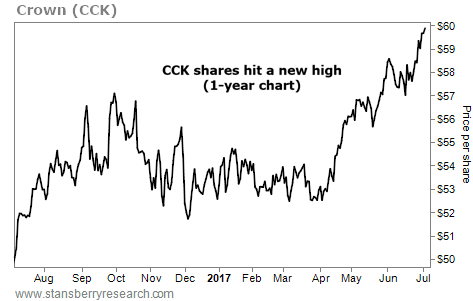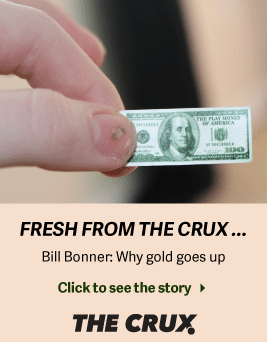| Home | About Us | Resources | Archive | Free Reports | Market Window |
Massive Buy Signal: Goldman Bails on CommoditiesBy
Thursday, July 6, 2017
Goldman Sachs wants out of the commodities business.
Who cares, right? Who trades commodities like corn anymore?
You might not think this is a big deal... But it is...
You'd be shocked at how often Wall Street firms get OUT of a sector – at EXACTLY the wrong time.
Goldman's likely exit from commodities might just end up signaling the bottom in commodities prices. Let me explain why...
Goldman Sachs is the leading commodities firm among Wall Street banks. It generated $3.4 billion in revenues from commodities in just one year (2009). But after years of falling commodity prices, Goldman's revenues in commodities have plummeted. Last year, the company's commodity revenues were just $1.1 billion.
Any executive "suit" or "bean counter" at Goldman would look at the falling revenues and say it's time to cut out that division. And how could you argue? Revenues are down by two-thirds since 2009.
Commodities prices have performed terribly in recent years. Take a look...
And the pain doesn't end there... Commodities prices are down 5% this year so far. That means they've fallen in six of the past seven years. Goldman is not the first to think about bailing on commodities... According to Bloomberg, a slew of financial-services firms – Morgan Stanley, JPMorgan Chase, Barclays, and Deutsche Bank – have all either cut back or exited commodities trading in recent years.
So why is this good news for commodity prices? Why would Goldman's exit be a potentially massive buy signal?
It's because of a principle that I learned firsthand nearly 20 years ago... and have applied successfully since...
One of my investing heroes is a guy named Jim Rogers. Jim delivered a 4,200% return over 10 years as co-manager of the Quantum Fund in the 1970s.
My business partner Porter Stansberry and I have gotten to know Jim over the years. He made a huge impact on us when we hung out with him in New Orleans in the late '90s.
In 1998 – when everyone was thinking about stocks – Jim told us he was out of the stock market. Instead, he was downright giddy about the upside potential in commodities.
He told us that when he heard Merrill Lynch was getting out of the commodities business that year, he "couldn't stop smiling."
You could hardly blame the suits and bean counters at Merrill Lynch's corporate offices for getting out of commodities back then. Commodities were the worst-performing asset class out of all asset classes for two consecutive years (1997 and 1998).
Jim absolutely nailed the opportunity... Commodities went up more than 20% a year – in five of the next seven years!
Merrill Lynch's suits gave up on commodities at exactly the wrong time.
I took note of what Jim had done. I knew I would use the same principle at some point.
My opportunity came in late 2002...
That year, Merrill Lynch let go of Martin Fridson. Known as "the dean of the high-yield bond market," Fridson is the smartest guy in the room when it comes to high-yield debt. It was one of many signs that Wall Street was giving up on high-yield bonds.
High-yield bonds had been the worst-performing sector of bonds in three of the five previous years (1998, 2000, and 2002). So the suits at Merrill Lynch decided it was time to cut back on the company's high-yield-bonds department.
You can guess what happened next...
High-yield bonds were the best-performing bonds the next year – delivering a near-30% gain in 2003.
Not only that, but high-yield bonds were the best-performing bonds in three of the next four years... again, after Merrill Lynch let Fridson go. The company's exit from the high-yield bond market was a sign of the bottom.
So, let me remind you of where we stand today:
Based on history, we're seeing the classic signs. It might just be anecdotal evidence... But it looks like a major buying opportunity in commodities is imminent. When the uptrend returns, we will get back in. Good investing,
Steve
Further Reading:
The important thing to know about investing in commodities is that they're incredibly cyclical. And as resource guru Rick Rule explains in this classic interview, if you catch one of the upcycles early, you may never have to work again. Read more here: Mastering the Resource Market's Cyclicality.
Market NotesA GLOBAL LEADER IN PACKAGING Today's chart highlights one of our favorite strategies at work... buying companies that sell simple products.
You don't need to sell flashy or innovative products to have a successful business. "Boring" products like Marlboros, Twinkies, and Pepsi are always in demand. These staples are the cornerstones of steady, profitable businesses that generate good cash flows for investors. For proof, we'll look at a leader in "metal packaging"...
Crown (CCK) is a leader in the packaging industry. It's the No. 1 producer of food cans worldwide – and the second-largest producer of beverage cans. The company operates in 36 countries and employs 24,000 people. Packaging may not be exciting, but it's crucial to food quality and preservation... So Crown's metal containers are always needed.
As you can see, shares of CCK have soared lately. They're up nearly 20% in the past year alone, and they recently hit a new all-time high. It's more proof that investing in simple businesses isn't exciting, but it works...
 |
Recent Articles
|



